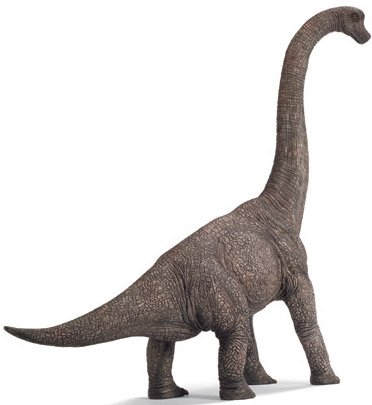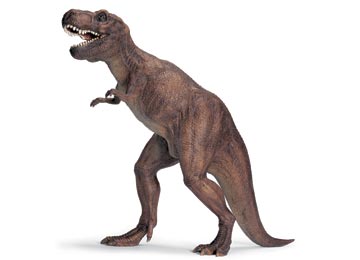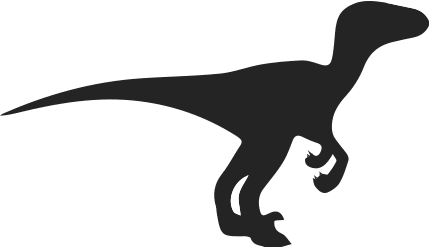Dinosaurs
Brachiosaurus | Compsognathus | Dilophosaurus | Gallimimus | Parasaurolophus | Psittacosaurus | Triceratops | Tyrannosaurus Rex | Velociraptor

Brachiosaurus Altithorax
“Brachiosaurus”
(Latin bracchium = “arm” + Greek sauros = “lizard”)
Size: 25 meters (82 feet)
Period: Late Jurassic (156 million to 145 million years ago)
Place: Colorado, Tanzania
Distinguished by a remarkably long neck and supported by a tremendously powerful backbone, the Brachiosaurus is often compared to the giraffe largely due to its asymmetrical body design: the front legs are longer than the back, creating a sloping effect that makes the creature look even bigger than its already gargantuan height. The front feet each feature a single claw, while the hind feet each have three. While perhaps intended as defensive measures – as if a healthy Brachiosaurus needed to worry about predators – the claws have proven to fulfill the more curious purpose of gathering food, as described below.
Environment: Due to its disproportionately large nostrils, it was originally hoped that the Brachiosaurus would reside mainly in the lagoon. Once immersed, however, the substantially higher water pressure at lower depths made breathing impossible. After a few tragic experiments, the decision was made to move the Brachiosaurus to the plains.
Feeding: Plant-eater. While the Brachiosaurus prefers to eat from tree tops, it has surprised everyone with a method of gathering food unique among the other dinosaurs. Using its front legs for support, the creature is able to “harvest” its meals from the grassy plains, tearing the foliage from the soil with its clawed hind legs.
Habits: Solitary nature. Some concern has been expressed over the creature’s decidedly low libido. Testing continues.
Ops Notes: Aside from the (relatively) active exercise of gathering food, the Brachiosaurus has proven to be a disappointment in the personality department. It has proven difficult to maintain a healthy population, as many of the creatures have been dying suddenly. Cause of death remains a mystery.

Compsognathus Longipes
“Compy”
(Greek kompsos = “elegant” + Greek gnathos = “jaw”)
Size: 1 meter (40 inches)
Period: Late Jurassic (156 million to 145 million years ago)
Place: Germany, France
The smallest dinosaur in Jurassic Park has proven to be a fierce predator, thanks to a long neck, powerfully-clawed fingers, and massive upper legbones, enabling it to reach surprisingly fast speeds. Feet are also clawed, used to grasp prey.
Environment: The Compy has seemed content to inhabit the plains and semi-arid areas, although some have been introduced into the marsh regions with varying degrees of success.
Feeding: Depends on the environment. Compys in the plains and semi-arid regions feast on a constantly-replenished supply of small lizards, while those who have remained in the marsh feed almost exclusively on insects, although they have reportedly made attempts at frogs and even a snake.
Habits: Comfortably solitary, the Compys will occasionally form loosely-knit herds when pursuing larger prey.
Ops Notes: Up to now, have demonstrated the least intelligence of any of the dinosaurs in Jurassic Park. There have been some reports of lost kittens in the Toluca Lake area. While there have been some whispered allegations concerning the Compys’ complicity, no definitive link has been established.
Dilophosaurus Wetherill
“Dilophosaur”
(Greek di = “two” + Greek lophos = “crest” + Greek sauros = “lizard”)
Size: 6 meters (20 feet)
Period: Early Jurassic (208 million to 194 million years ago)
Place: Arizona
One of Jurassic Park’s stranger residents, the Dilophosaurus possesses unusually long forelimbs and a disproportionately large (although surprisingly delicate) head. The truly distinguishing feature, however, is the pair of arched crests positioned on top of its head from which multi-colored, almost hypnotic cowls fan out.
Environment: The Dilophosaurs have demonstrated a propensity to roam wherever the hunt might take them, adapting with ease to (but rarely settling in) nearly any environment.
Feeding: Carnivore. The Dilophosaur was originally thought to be a scavenger, as its thin teeth and delicate head make traditional hunting impossible. But the creature surprised everyone with its ability to shoot a semi-toxic liquid, capable of stunning potential prey. The creature’s deadly proficiency with its limber arms and legs, complete with razor-sharp claws, combined with a tendency to hunt in packs has transformed the Dilophosaurs into perhaps the Park’s most efficient hunter of prey.
Habits: With few exceptions, the Dilophosaur are a tightly-knit herd, traveling in organized fashion. Recent field observations have suggested that the creatures participate in a complex culture, apparently abiding by a communal set of social manners whether resting, breeding or hunting.
Ops Notes: The emergence of the Dilophosaur as a cold and calculating hunter, capable of coordinating group attacks with surprising efficiency, has frightened more than a few people at InGen.

Gallimimus Bullatus
“Gallimimus”
(Latin gallus = “chicken” + Greek mimos = “mimic”)
Size: 5 meters (17 feet)
Period: Late Cretaceous (75 million to 70 million years ago)
Place: Gobi Desert, Mongolia
Similar in shape to the ostrich, the Gallimimus is Jurassic Park’s fastest inhabitant, able to run as fast as 50 miles an hour, thanks to long legs and a relatively light body. It features a long bill and a shovel-like lower jaw.
Environment: Predominantly in the semi-arid region.
Feeding: The Gallimimus collects its meals – mostly small insects and worms – in an entertaining manner. Lacking in depth perception (the creature’s eyes are fixed on either side of its head), the animal searches the ground for prey using its otherwise weak and useless arms. Upon discovering a potential meal, the Gallimimus proceeds to devour the entire area – including dirt and small rocks – with a ravenous appetite bordering on the comical.
Habits: Possessing decidedly less intelligence than most of its fellow dinosaurs, these creatures tend to live a very simple life. A typical day consists of combing the ground for prey (as described above) while avoiding predators with its tremendous speed.
Ops Notes: A mildly entertaining curiousity, the word around InGen is that the Gallimimus was chosen by Genetics as a practical joke. An extremely hyperactive and skittish creature, it’s nearly impossible to approach one.

Parasaurolophus Walkeri
“Parasaur”
(Greek para = “by” + Greek sauros = “lizard” + Greek lophos = “crest”)
Size: 9 meters (30 feet)
Period: Late Cretaceous (76 million to 65 million years ago)
Place: Alberta, Utah, New Mexico
Able to walk on two feet as easily as four, the duckbilled (lambeosaurine) Parasaur is distinguished by its skull crest, an elongated, curved structure longer than the entire skull. This crest contains two hollow tubes, originally believed to be a respiratory device used in similar fashion to a snorkel. However, the true purpose of the tubes turns out to be for the creation of sound. The Parasaur is able to use these tubes to communicate with its fellow herd members through the emission of low-frequency vocal resonances.
Environment: The Parasaur generally abides – per original estimates – in the forest region. It has, however, shown a remarkable adaptability and has migrated at times to the plains, semi-arid, and most recently, the swamp regions of the Park.
Feeding: Plant-eater. Content to feast on the ferns and foliage of the forest, although has demonstrated a new predilection for some of the water-based mosses in the swamp area.
Habits: The Parasaurs tend to group in herds, falling into a rigid social hierarchy. Males seem to achieve dominance in relation to the coloration of their skull crests with the more spectacularly-plumed Parasaurs adopting the leadership roles. Female social strata appears to be based on resonance of voice – the females capable of creating sounds at lower frequencies have repeatedly attracted the attention of the more brightly-colored males.
Ops Notes: Some concern over the Parasaurs’ amazing adaptability. The skull crest is retractable, allowing for rapid movement through dense foliage. Several red flags have been raised over their highly-evolved ability to communicate with one another: while it’s a bit premature to fear a Parasaur conspiracy, the beasts have demonstrated some rudimentary higher-level linguistic skills rivaling those of some monkeys.

Psittacosaurus Mongliensis
“Psittacosaurus”
(Greek psittakos = “parrot” + Greek saurus = “lizard”)
Size: 2 meters (7 feet)
Period: Early Cretaceous (119 million to 97.5 million years ago)
Place: Mongolia, China, Thailand
One of the early Ceratopians (the family of horned creatures which later evolved to include the more popular Triceratops), these “old-timers” have won a special place in the hearts of the visitors. These two-legged runners feature a square skull and a powerful (albeit toothless) “beak.” The Psittacosaurus can make limited use of its four-fingered hands, especially where gathering food is concerned.
Environment: These beasts prefer the forest where edible foliage is abundant. The nearby T-Rex, however, has sent many a skittish Psittacosaurus running for the semi-arid areas.
Feeding: These toothless vegetarians make ample use of their powerful beaks, feasting on whatever foliage is available.
Habits: Harmless, toothless and guileless, these geriatric-looking beasts come closer to actual friendliness than any other dinosaur in the park. While nervous around the other animals, they have taken quite an affinity to people, often approaching the boats.
Ops Notes: While more interesting dinosaurs have since been created, these early efforts have proven their staying power, consistently remaining one of the favorite attractions in the Ride. One InGen rumor directly attributes their continued survival to their charisma. According to legend, Hammond was considering “pulling the plug” on the Psittacosaurus until he caught wind of their popularity.

Triceratops Horridus
“Triceratops”
(Greek tri = “three” + Greek keratos = “horn” + Greek ops = “face”)
Size: 9 meters (30 feet)
Period: Late Cretaceous (68 million to 65 million years ago)
Place: Colorado, Wyoming, Montana, South Dakota, Alberta
The Triceratops’ distinctive features were familiar to nearly all even before the opening of the park. A short horn on the nose is supplemented by two larger horns on the forehead, averaging some 3 feet in length. These massive creatures also wield one of nature’s most formidable defense mechanisms, a 2.5 meter (7.5 feet) neck frill composed of a solid sheet of bone. Many of these neck frills possess barnacle-like knobs as well, adding further protection.
Environment: Creating a suitable habitat for the Triceratops has turned out to be more difficult than originally anticipated. The most successful colonies currently reside in the plains and semi-arid regions.
Feeding: Much of the difficulty in acclimating the Triceratops to the Jurassic Park environment is directly caused by the creature’s specific food needs. While a strict herbivore, the Triceratops’ elongated teeth, while extremely sharp, have proven to be less than suitable for chewing ordinary leafy plants. While palm fronds gathered by Rangers from the trees around Universal Studios Hollywood have sustained the creatures so far, there is much concern over finding a more consistent source of nutrition for these hearty eaters.
Habits: The attempt to understand the Triceratops’ social behavior has resulted in a sort of paradox. While preferring the company of others of its kind, the creatures generally spend a great deal of time fighting among themselves, sparring with their trademark horns.
Ops Notes: Let there be no doubt about it: the Triceratops is Hammond’s favorite inhabitant of the Park. With classic features familiar to nearly everyone and a propensity to brawl with one another in spectacular fashion, the Triceratops is a huge crowd-pleaser. Hammond has demonstrated an unwavering belief in the creatures’ marketability, lending a deaf ear to complaints over the difficulties of sustaining the increasing population.

Tyrannosaurus Rex
“Tyrannosaurus”
(Greek tyrannos = “ruler” + Greek sauros = “lizard”) Also known as “T-Rex”
Size: 13 meters (42 feet)
Period: Late Cretaceous (68 million to 65 million years ago)
Place: Colorado, Wyoming, Montana, South Dakota, New Mexico, Mongolia, China
Originally believed to be the most dangerous hunter ever to have walked the earth, the T-Rex has lived up to expectations. An enormous skull (approximately 1.5 meters, or 4.5 feet) contains a powerful set of dagger-shaped teeth, measuring 8 to 16 centimeters (3 to 6 inches) in length and 2.5 centimeters (1 inch) wide. Its extremely functional arms (90 centimeters, or about 3 feet long) can lift weights approaching 500 pounds, and the highly-developed legs allow the creature to run nearly 25 miles per hour. Add the incredibly developed senses – including binocular vision, superior hearing and a keen sense of smell – and one begins to believe all of the hype.
Environment: The original plan was to insert the T-Rex in the plains and semi-arid regions, as the Park’s designers hoped to impress crowds with its dazzling hunting abilities. The beast has proven to be a bit of a disappointment in the showmanship department, however, tending to conceal itself in the forest.
Feeding: Adding to this disappointment is the realization that, when able, the carnivorous T-Rex prefers to scavenge the remains of dead meat rather than hunting for fresh prey.
Habits: Despite all the trappings, the T-Rex has repeatedly demonstrated a kindly nature. Seemingly content to dine on carcasses in the quiet seclusion of the forest, the T-Rex has turned out to be Jurassic Park’s unlikely model citizen.
Ops Notes: While the T-Rex has failed to live up to its original (and overly optimistic) expectations, the Genetics Division maintains high hopes of effecting a serious attitude adjustment. Recent efforts have concentrated on increasing the creature’s visibility.

Velociraptor Mongoliensis
“Velociraptor”
(Latin velox = “swift” + Latin raptor = “robber”)
Size: 2 meters (7 feet)
Period: Late Cretaceous and early Campanian (85 million to 80 million years ago)
Place: Mongolia, China, Russia
A swift predator with long claws and sharp teeth, the “Raptor” was originally intended as dinner for the more popular Tyrannosaur. While its larger counterpart has adopted a more sedentary lifestyle, however, the flat-snouted Raptor has grabbed the limelight. With surprising smarts, disproportionately large eyes and a love of the hunt, this beast has both amazed and terrified the Park’s visitors.
Environment: Due to its violent nature, the Raptor has been confined to its own pen, composed of grassy plains and a small lake.
Feeding: While the Raptor will eat almost any meat, it seems to prefer fresh kill. The live cows that are occasionally released into the pen invariably meet the same fate. After being cornered by a coordinated attack, the hapless cow is generally gripped by the Raptors’ long fingers, slashed open by a the razor-sharp, sickle-shaped claws adorning the Raptors’ feet, then gnawed to death by the creatures’ abundant teeth.
Habits: Crafty and cunning, these creatures are killing machines. While their apparent intelligence is perhaps overrated, there’s little doubt that these creatures cooperate together out of a single, common desire: the love of the hunt.
Ops Notes: One of the Park’s biggest surprises, no one – including Hammond – seems to know what to do with the cunning Raptor. Until some final decision can be reached, the creature remains segregated from the other dinosaurs in its own pen. The Raptor has proven to be of great interest to the scientists in Genetics, whose numerous experiments upon the creature reflect a desire to learn more about its dark motivations.
Dinosaur Image Sources: Brachiosaurus, Compsognathus, Dilophosaurus, Gallimimus, Parasaurolophus, Psittacosaurus, Triceratiops, Tyrannosaurus Rex, Velociraptor

